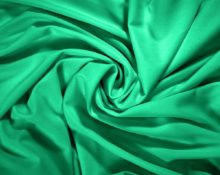Linen came to us from Ancient China, where it was used for sewing capes and kimonos. The products were based on silk materials. Multilayer fabric later appeared in European countries, then in the USA. In the Middle Ages, the material was used for sewing clothes. It was decorated with various stitches made of multi-colored threads. Laces and braid were used for decoration. The fabric retains heat perfectly even in cold weather. Residents of Britain used it when sewing hunting clothes - warm jackets, vests and coats. Quilted fabric is an excellent material for sewing bedspreads, blankets, and linings.

Quilted textiles - what is it?
Matter consists of several layers. Their minimum quantity is three pieces. These are two fabric bases and insulation in the middle. Stitching is used to hold the layers together, so the surface of the canvas is decorated with a three-dimensional pattern. The material may consist of synthetics, natural raw materials, or have a complex composition. It depends on the area of application of the fabric:
- A blanket or pillow is made of cotton with polyester, wool or microfiber.
- Outerwear is made from quilted synthetic-based fabric. The reverse side is made of fleece or microfiber.
- Blankets, bedspreads, and other textile items are made from materials that include polyester, cotton and viscose.
Craftsmen make various stitches, depicting flowers, ornaments, patterns and much more. The number of layers can be greater if a membrane, water-repellent fabric is added inside.
Quilted fabric - varieties
There are several types of quilted fabric, the main ones:
- Knitted quilted fabrics. The base is cotton. It is complemented by polyester or spandex. Insulated with padding polyester. They are distinguished by plasticity and softness. The material is thin and tactilely pleasant. Can be used for sewing windbreakers, light sweaters, jackets, dresses, sweatshirts.
- Raincoat quilted fabric. To create the top layer, polyester or bologna is used. The inner side is polar fleece, fleece. Insulated with padding polyester. Fabric for summer clothes is not supplemented with insulation. Sewing of tourist and sports sets, trowels, raincoats is carried out.
- Leather quilted fabrics. More often, artificial leather is used for stitching. Use thermal stitch or thread version. Suitable for making jackets, bags, coats, belts.
- Quilted lining material. Production requires polycotton, satin or calico. The inner part is batting, holofiber or other filler options. Used in working with children's and adult outerwear. The material warms perfectly, while the skin breathes freely.
- Material for jackets. The front part is synthetic, the back part is made of cotton, fleece or microfiber. A layer of faux fur, padding polyester, holofiber, and batting is placed inside.Used for sewing clothes for adults and children. The top side is impregnated with special agents that repel moisture.

Each type of fabric has its own purpose, its advantages and disadvantages. The external characteristics of the fabric are perfectly conveyed by photography or video. It looks beautiful, original, and due to the stitch patterns it looks elegant.
Quilted material - advantages
The fabric has many advantages, in addition to its interesting appearance. These include:
- Resistance to washing - the fabric does not shrink or deteriorate.
- Things do not lose their color even in open sunlight.
- The fabric is wear-resistant, reliable, durable.
- The material is light, soft, allows the body to breathe.
- The wind does not blow through the quilted fabric.
- The fabric can reliably retain heat and wick away moisture.
Due to the stitching, the bulk of the garment is reduced and it looks more elegant. The fabric is very easy to work with, both at the cutting stage and during the sewing process.


 0
0





